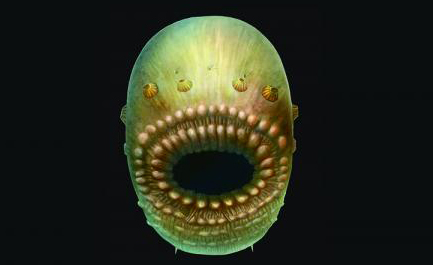Unravelling the Origin of the Deuterostomes
Saccorhytus coronarious – Our Earliest Ancestor?
It might resemble that green, slimy ghost/monster out of the movie Ghostbusters, but this tiny sack-like creature with a huge mouth (and no obvious signs of an anus), might just be our earliest ancestor. Scientists writing in the journal “Nature” report on the discovery of Saccorhytus coronarious a tiny organism less than one millimetre in diameter that could represent the oldest “deuterostome” yet discovered. Deuterostomes are divided into three major clades, one of which is the Chordata, that’s the vertebrates which includes us! This animal could represent your earliest known ancestor!
An Illustration of the Minute Saccorhytus coronarious – Our Earliest Ancestor?
Picture credit: Cambridge University
Deuterostomes
Within the Animal Kingdom (Animalia), the complex organisms, (more complex than jellyfish with their radial symmetry), are split into two main groups namely:
- Deuterostomia – bilateral symmetry mainly, with only the echinoderms showing radial symmetry, this group includes all the Chordata, plus the Hemichordata – acorn worms and the extinct graptolites and the Echinodermata star fish, sea urchins etc.
- Protostomia – bilateral symmetry including the molluscs, arthropods, nematodes and worms.
These lineages are believed to share a common ancestor that lived during the Ediacaran geological period. The hunt has been on to find this common ancestor, and Saccorhytus is the best candidate discovered to date. Firstly, it is the most primitive example of a deuterostome yet discovered and it is the oldest, having been discovered in rocks laid down some 540 million-years-ago (Fortunian Stage of the Lower Cambrian).
Saccorhytus coronarious
The micro-fossils were discovered in rocks in Shaanxi Province, (central China) and when it comes to identifying vertebrate features, that is a bit tricky, despite the remarkable degree of preservation.
A Highly-Magnified Image Showing the Micro-fossil (S. coronarious)
Picture credit: Jian Han
The body is bag-like and has a huge, mouth located in the centre (the oval shaped object in the central part of the organism). It has four conical openings on either side of the body, that may well have served as outlets to allow sea water that had passed into the body to be ejected. It has been suggested that these simple openings could provide an insight into the origin and development of gills.
The Mouth of Saccorhytus coronarious Probably Served Two Functions
The mouth probably served two functions, as the researchers have not been able to detect the presence of an anus. What entered into the mouth, once nutrients had been extracted, was ejected out of the mouth. The organism does show bilateral symmetry, however, a trait that was passed onto all the vertebrates.
Living in the Sand
Saccorhytus could have easily sat on the head of a pin. It probably lived between grains of sand on the seabed, wriggling its way through them, perhaps it was an active predator, perhaps it fed on waste or other detritus. The study was carried out by an international team of academics, including researchers from the University of Cambridge in the UK and North-west University in Xian China, with support from other colleagues at institutions in China and Germany.
Simon Conway Morris, Professor of Evolutionary Palaeobiology and a Fellow of St John’s College, University of Cambridge, one of the co-authors of the study, commented:
“We think that as an early deuterostome this may represent the primitive beginnings of a very diverse range of species, including ourselves. To the naked eye, the fossils we studied look like tiny black grains, but under the microscope the level of detail is jaw-dropping. All deuterostomes had a common ancestor, and we think that is what we are looking at here.”
Fossils Show a Wide Degree of Diversity and Variety
Most of the very early deuterostome groups are known from fossils that date from between 510-520 million years ago, but these fossils already show a wide degree of diversity and variety so, if they did share a common ancestor, it probably lived much earlier. What the common ancestor might have looked like has also been extremely difficult to work out, given the level of diversity and variety already found in the fossil record from 510-520 million years ago.
The scientific paper: “Meiofaunal deuterostomes from the basal Cambrian of Shaanxi (China)”, published in the journal “Nature”.
Visit the Everything Dinosaur website: Everything Dinosaur.



